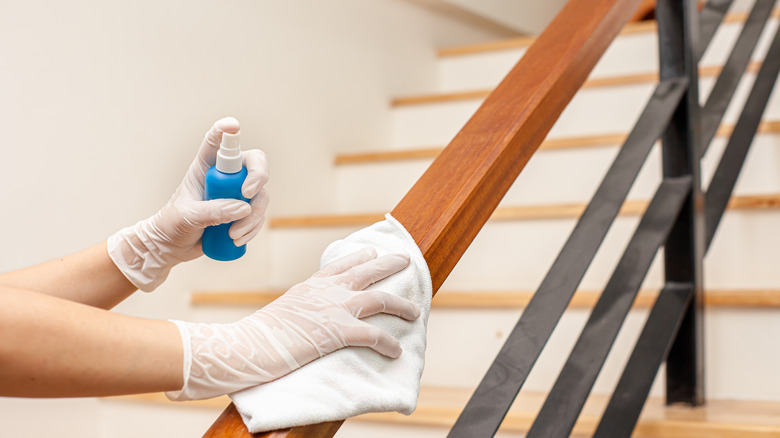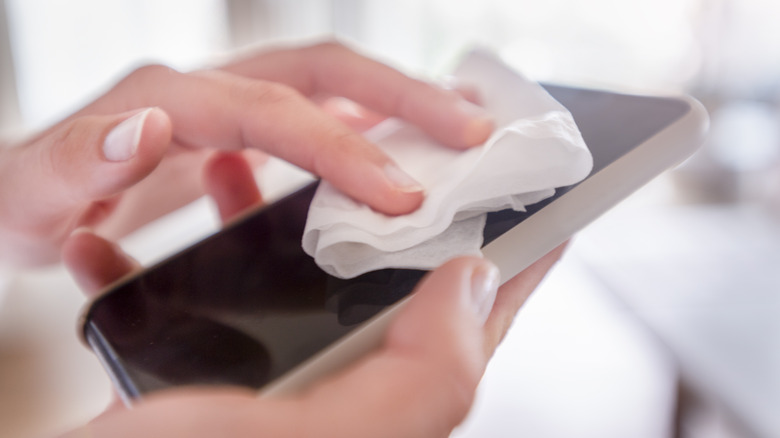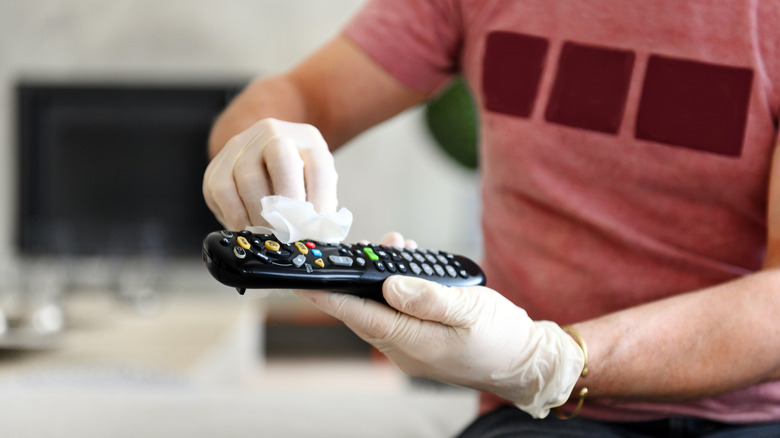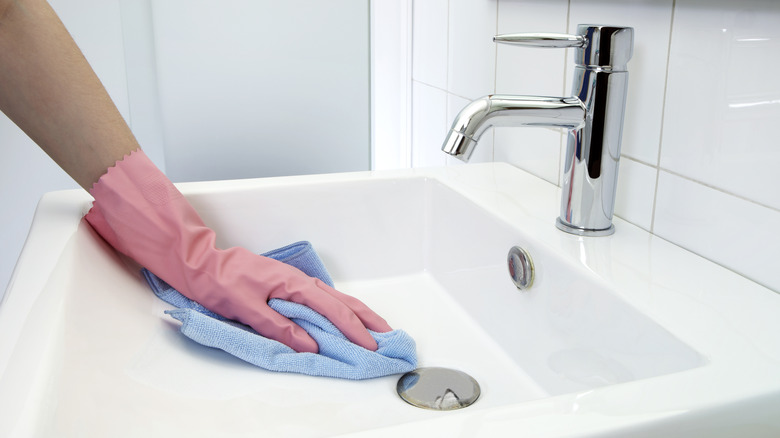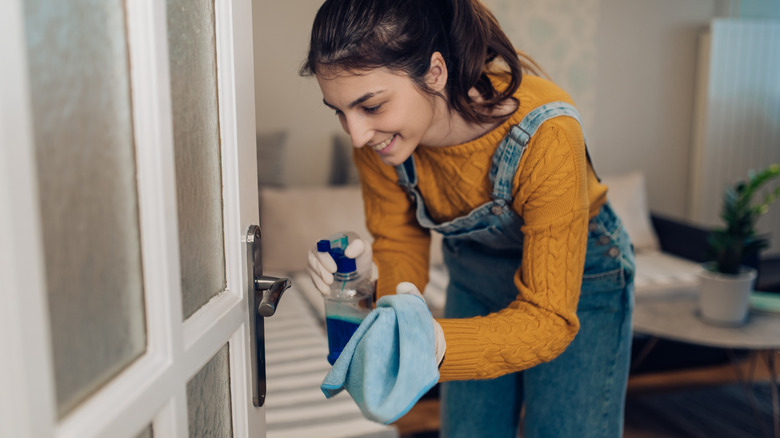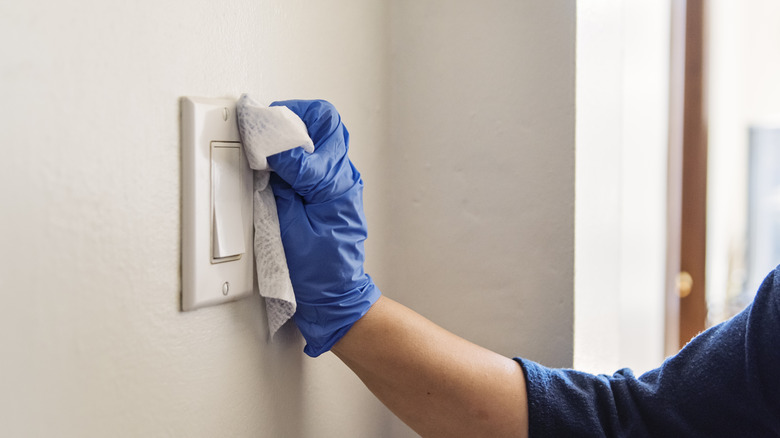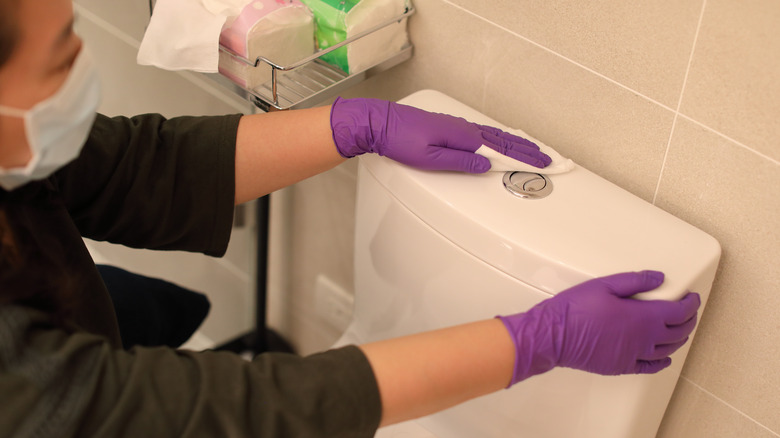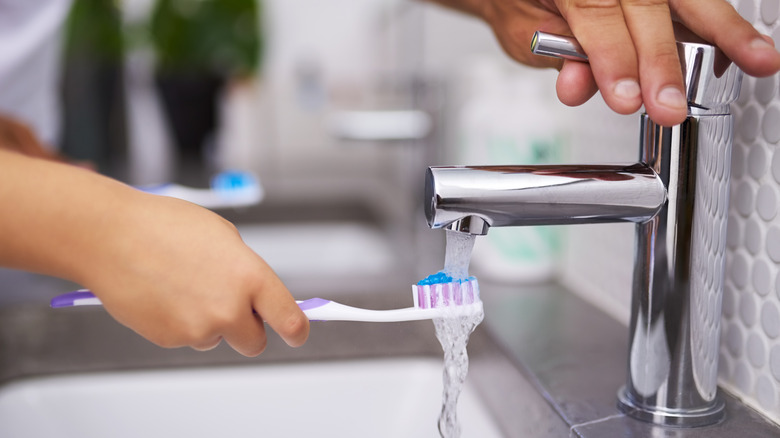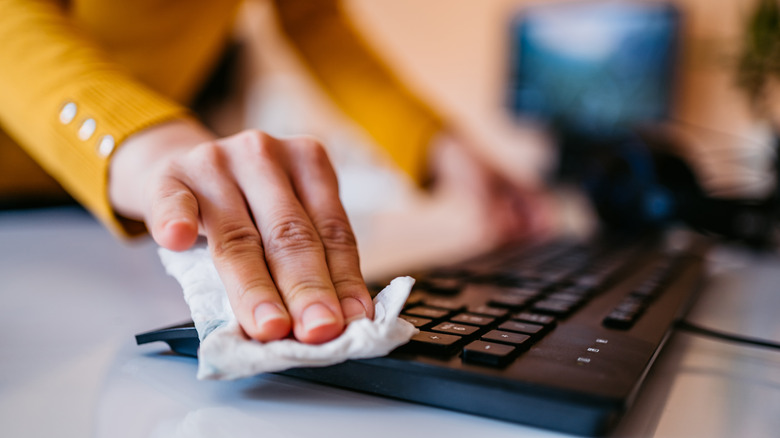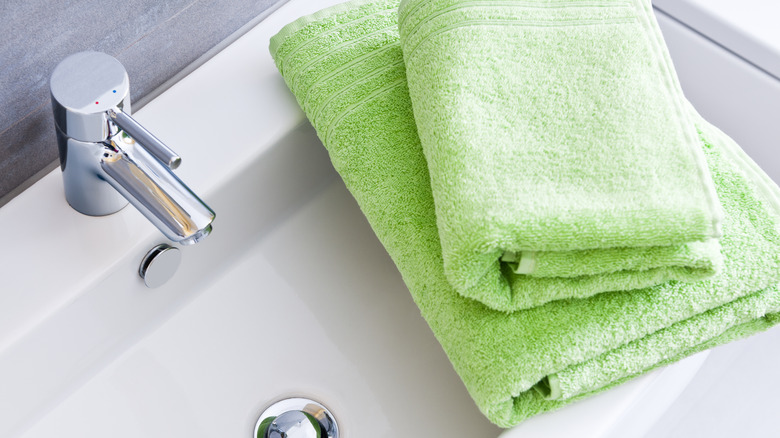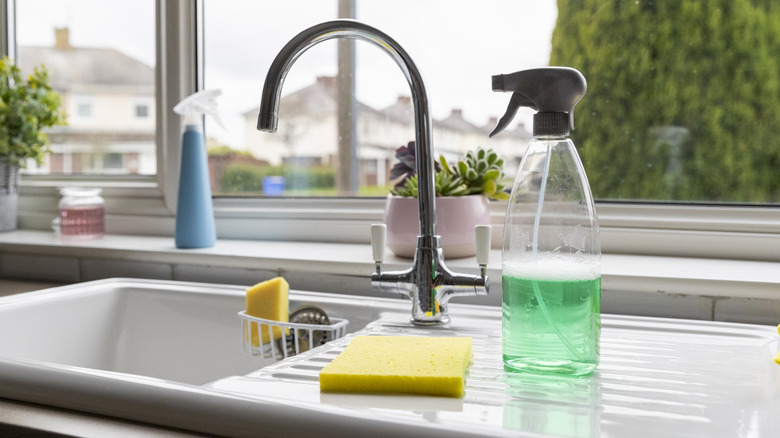The Dirtiest Surfaces In Your Home And How Often You Should Be Cleaning Them
Keeping your home tidy can be hard enough, but when you stop to consider all the germs and bacteria hiding in plain sight, it can feel like you're never cleaning enough. Don't worry; even some of the dirtiest surfaces in your home don't need to be cleaned every day. The key to keeping up with the germs and the mess all at once is to create an effective cleaning schedule, and that starts with knowing how often you should be cleaning the grimier areas of your home.
So, what areas make the list as the germiest? Obviously, certain spaces will be gross — like the toilet bowl — which contains 3.2 million bacteria per square inch on average. There are other surfaces throughout your home that are less obvious, though, which may actually be far dirtier than your toilet, if you can believe it. Developing a cleaning schedule around these hotspots can help keep your home clean and those living within it healthy. But first, they need to be identified.
Your phone should be sanitized daily
Phones have become a huge staple in almost everyone's life. No longer are they just a feature in the home — they're always with us. Because of this, phones are pretty gross. How gross? StateFoodSafety Resources says that cell phones have 25,127 bacteria per square inch. For reference? That's nearly 12 times that amount of bacteria per square inch in your pet's used food dish, which has about 2,110. It's hard to believe you'd put one against your face and not the other.
Due to their ability to amass germs, phones should be cleaned daily. While you should check with the phone manufacturer's instructions on cleaning your phone, there are some pretty universal steps you can take to sanitize your cell and other devices. First, unplug and power down for a lower chance of liquid damage. Then, gently rub your screen and case down with a non-abrasive cloth dampened with warm, soapy water. Try not to use sprays, and don't use bleach. Depending on your specific phone, you might be able to use a disinfectant wipe, but first check with the maintenance instructions to be sure you won't wear down the protective coating on the screen.
Remotes should be cleaned at least monthly
As often as we use remote controls, they often go overlooked when it comes time to clean. Usually, you may wait until there is something on the remote to actually clean it, such as food residue after an on-the-couch dinner movie. However, remotes are handled often and usually not right after someone's washed their hands, leading to them being covered in germs. GoodToKnow reported that a dirty TV remote has 290 colony-forming units per squared centimeter on its surface. For reference, the lid to your trash can has roughly 262.
Because of this, you should be cleaning your remotes at least monthly. Cleaning your remote can be simple if you know what you're doing; you only have to follow a few steps. As with any electronics, you should disable the power. In this case, you should remove the batteries. Use an alcohol wipe or rubbing alcohol and cotton swabs so the remote doesn't get wet like it would with a spray. Use a toothpick to go after gunk build-up, especially in the little nooks and crannies. Dry the remote off with a clean cloth, put the batteries back in, and you're done!
Sinks should be cleaned daily
Whether the sink in question is in the bathroom or the kitchen doesn't matter; any sinks in your home should be wiped down daily, if possible. Even the cleanest-looking sink hides tons of dangerous bacteria. The bathroom sink gets a build-up of the exact germs you're washing off your hands after using the bathroom, and the kitchen sink is a popular spot for E. coli and Salmonella. NBC News reports that when you wash your hands in these dirty sinks, the water can splash back onto you and re-contaminate your skin. This seems considerably likely considering just how many germs are in your sink; BioCote reported that the sinks in public restrooms are dirtier than the toilets, coming in hot with 50,000 bacteria colony counts.
Don't worry; disinfecting your sinks daily doesn't have to be a grueling or time-consuming chore. While you should use expert methods to thoroughly scrub down your sink from time to time, a simple wipe-down will do for your everyday disinfecting. The easiest method is to use a disinfecting wipe, or for the DIYers out there, you can use a spray of water and white vinegar paired with a clean cloth. When you're done, simply rinse with hot water.
Doorknobs should be sanitized weekly
It's a bit of a no-brainer that things that get touched a lot will be dirty, but do you actually remember the last time you cleaned the doorknobs in your home? While out in public, the germ-aware may go out of their way to avoid touching public door handles, but in the safer and cleaner feeling environment of our own homes, you may not think about how many germs they may harbor. Some doorknob materials are resistant to bacteria growth, such as copper and brass, but the ever-popular stainless steel is less so, as proven by a study from the University of Southhampton. So, how many bacteria can be found on these less-resistant handles? Penn State University conducted a study in 2016 and found a single door handle topped with four colonies of bacteria, each of which had more than a million individual bacteria within it. And this was a cafeteria door, not a bathroom one!
Don't worry; you won't need to start treating your front door like a bio-hazard if you sanitize it weekly in a few easy steps. Spray down your doorknobs and handles with isopropyl alcohol or soap and water. Disinfecting wipes are another great resource for quick door knob cleaning, especially those with quaternary ammonium compounds.
Light switches should be cleaned every other week
Just like doorknobs that are touched daily by many hands, light switches carry the same risk. This is another spot that gets overlooked when it comes time to clean house, but it isn't one that should be skipped; light switches should be cleaned every two weeks. This recommendation certainly seems reasonable, considering light switches have 217 bacteria per square inch, according to Lancaster General Health.
Before you start your bi-weekly cleaning, a quick warning: Because light switches are electrical, you should never use spray or copious amounts of liquid when cleaning them. For any deep cleaning, make sure the power to that switch is turned off. If you're not trying to get the gunk out of nooks and crannies, a simple wipe will do. You can use any sanitizing or disinfectant wipe to do so; just make sure it's damp and not wet. If you don't like using disposable wipes, you can also spray a microfiber cloth with disinfectant spray and use it as a washable wipe.
Toilet handles should be cleaned daily
The toilet is one of the most obvious sources of bacteria in the home, and you certainly wouldn't count a clean-looking bowl as safe to touch. However, many people forget that toilet germs aren't just in the bowl; the entire toilet is crawling with bacteria. One such place that everyone touches is the toilet handle, and while you wash your hands right afterward, it's best to keep a clean environment to minimize exposure to harmful bacteria. But just how dirty is a toilet handle, anyway? Business Hygiene Texas reports that handles have, on average, 83 bacteria per square inch, with some being just as dirty and bacteria-coated as the bathroom floor.
You can use a multipurpose cleaner or a disinfectant to clean the toilet handle daily. Just spray and wipe. If you're using a disinfectant, give it anywhere from 30 seconds to 10 minutes to kill the germs before wiping it down. Check the label for specific instructions. If you're cleaning the whole outside of the toilet, start at the top and work your way down. Remember, any towel, rag, or scrub brush you use to clean any part of the toilet should not be used on any other surface.
Toothbrushes and holders should be disinfected weekly
Toothbrushes are used to clean our teeth and mouths, so it stands to reason that they would be clean, too, right? Wrong; toothbrushes are some of the dirtiest objects in our homes. Just how dirty? The British Dental Journal says that research shows that a toothbrush can have as many as 10 million bacteria and germs on it. Don't forget the toothbrush holder, either — Deluxe Maid says that toothbrush holders get third place for most germ-covered in the average household.
Luckily, the American Dental Association offers a handful of ways to disinfect your toothbrush every week. You can soak it in antibacterial mouthwash or hydrogen peroxide, rinsing thoroughly afterward. If you don't mind swapping your toothbrush out more often, you can also boil it for three minutes. Finally, you can try out a UV toothbrush sanitizer. Either way, you should still replace it every three to four months. For the holder, they should go through the dishwasher if possible. If not, they should be washed with hot, soapy water and a brush, then rinsed with hot water and wiped with a disinfecting solution.
Computer keyboards should be cleaned once a week
Using a public computer may make you cringe when you think about how many hands have been on the keyboard, but you may not think about how many germs are on your own personal computer keyboard. Even those who share a computer with the rest of their household often disregard how dirty the keys can get, and they can get pretty gross. According to a study by CBT Nuggets, they have over 3.5 million colony-forming units per square inch. The National Center for Health Research says that, on average, desktops have 400 times more germs than the toilet seat does.
Every week, you should wipe down your keyboard with a disinfectant wipe; make sure you aren't using bleach, which should not be used on electronics. As with all electronics, make sure you unplug or remove the batteries before you begin cleaning. For a quick wipe-down, you can use a microfiber rag sprayed with disinfectant for those who don't want to buy single-use wipes. Paper towels aren't recommended since small pieces can get left behind in the keys, but other anti-abrasive cloths work, too.
Hand towels should be washed every three days
Once again, the very object you use to help keep clean may be unexpectedly dirty itself. A study conducted at the University of Arizona found 90% of bathroom towels to be contaminated with coliform bacteria and E. coli. Oh, and your bathroom towels aren't the only hand towels guilty of this. The same bacteria were found on kitchen towels as well. These bacteria statistics correlated directly with how often these towels were washed.
Towels should be swapped every three days, or more frequently. You don't have to worry about running laundry constantly, of course; towels can sit in a laundry hamper until laundry day so long as they've been allowed to air-dry first, which will prevent them from growing more bacteria or developing a smell. You should not use more than 2 tablespoons of soap per load of towels, as more can cause residue build-up. Check the label on your towels for washing instructions first, but in general, towels can be washed in cool or cold water on the delicate cycle. You shouldn't use fabric softener on them, as the "softening" coating can create a barrier that makes your towels less absorbent; try using wool dryer balls instead.
Kitchen sponges should be cleaned every other day
Unsurprisingly, the average kitchen sponge is a breeding ground for bacteria, but most wouldn't know just how bad the issue is. A Scientific Reports study discovered that used kitchen sponges can carry up to 54 billion bacteria per cubic centimeter. And yes, some of those bacteria are indeed salmonella and E. coli. Again, though, many people already know that their sponges are gross but don't know how to make them clean again and prefer not to buy new sponges every time they do the dishes.
You may be surprised to hear that Agricultural Research Service researchers have found the best way to clean your sponge is to stick it in the microwave. Soak the sponge first, as a dry sponge could combust, and then stick it in the microwave for one minute. If you're uncomfortable with this method, put a clean sponge in the dishwasher on the dry cycle. It is suggested to clean them every other day and consistently replace them every two weeks or before they begin to smell or fall apart, whichever is sooner.
